Greek Sculpture Final Exam
1/80
There's no tags or description
Looks like no tags are added yet.
Name | Mastery | Learn | Test | Matching | Spaced |
|---|
No study sessions yet.
81 Terms
Naiskoi
grave stelae in the shape of a small temple with a pediment and sometimes columns. The deceased were carved in very high relief inside the niche created.
Lekthoi
marble vases used as grave markers in the late 5th c
Purpose of grave stelae
Multi-purposed: both used to commemorate and identify the burial place a lost loved one, to please the dead and celebrate them, and to prove lineage after Pericles’ citizenship law
Male grave stelae in the Classical Period
All ages were represented shown by the length of beard and amount of nudity
Those who died in a war were shown victorious in battle or shaking hands with family members or other hoplites
Young men were idealized as hunters or athlete
Some hold objects that hint at their profession
young men are sometimes depicted with hares
Often in family scenes
Female grave stelae in the Classical Period
Appear much more often compared to the Archaic due to Pericles’ citizenship laws that require proof that one’s mother and father were Athenian
Women are depicted as married or unmarried maidens and age is shown by size
Objects held by the deceased or their maidservant are often toiletry items, jewelry box (pyxis), and birds
Often appear in family scenes - athenian oikos
Extra
Women standing by a loutrophoros - vessel used for a nuptial bath - depict unmarried maidens
If the himation is drawn over the back of their head, they are married
Often seen shaking hands (dexios) with another figure or unveiling herself during a wedding ceremony (anakalypsis)
Express grief with short hair, touching face, and melancholy
bird carried by youth and maidens or married women playing w children
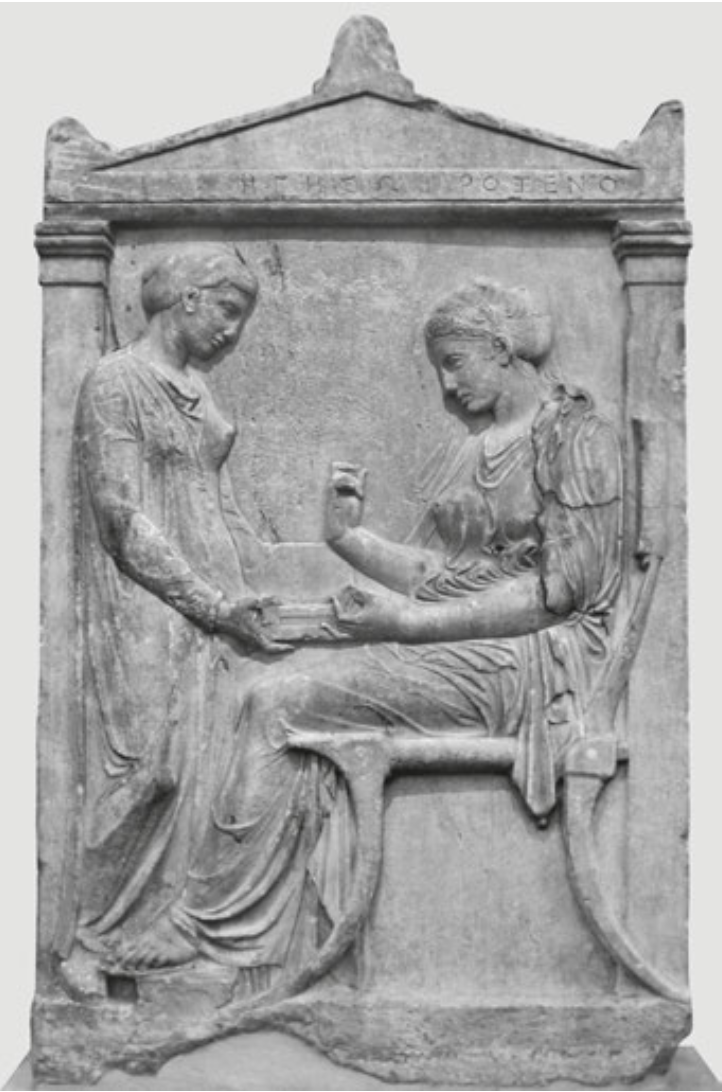
Name:
Date:
Era of Greek sculpture:
Artist:
Material:
Original and current location:
Original work or a copy:
Context:
Stylistic description:
Problems:
Hegeso Stele
400 BC
High Classical / Late Classical
Callimachus
Pentelic Marble
Kerameikos originally, National Archaeological Museum now
The original is in the NAM, and a cast is in situ at Kerameikos
Context:
Families began depicting women in funerary monuments after Pericles’ citizenship laws that require proof that one’s mother and father were Athenian
Stylistic:
“Mistress and Maid” theme: The dead woman is being assisted by her maidservant to look through her jewelry box. This is a domestic scene; it shows her living the ideal life for a women: in her home, high status, and surrounded by luxury
The woman is wearing a veil which indicates she was married. The fabric of her garment clings to her body.
She is ageless and beautiful (and very realistic), but melancholy and distant
This is a standardized scene. The workshop would have carved it and then patrons would have purchased and customized them.
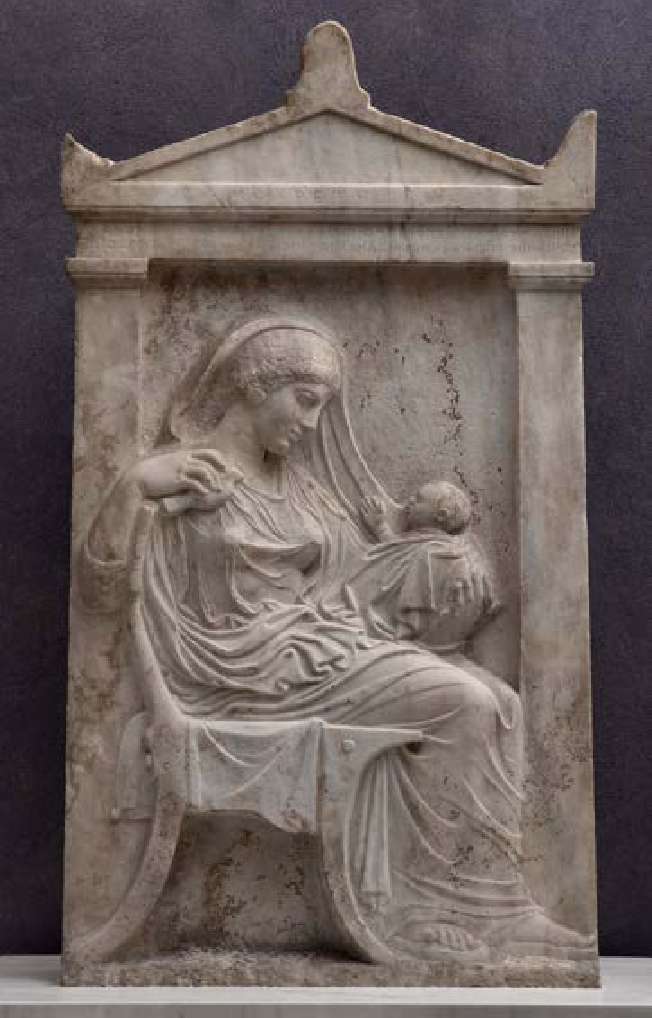
Name:
Date:
Era of Greek sculpture:
Artist:
Material:
Original and current location:
Original work or a copy:
Context:
Stylistic description:
Problems:
Ampharete Stele
420-400 BC
High Classical / Late Classical
Unknown
Pentelic Marble
Sacred Road to Kerameikos Museum
Original Work
Context:
Families began depicting women in funerary monuments after Pericles’ citizenship laws that require proof that one’s mother and father were Athenian
Additionally, children begin appearing in funerary reliefs after the Archaic.
Style:
Depicts a domestic scene: grandmother playing with her young male grandchild. She’s holding a bird in one hand, which adults only hold in funerary scenes when interacting with children.
Very naturalistic with more realistic babies and perspective, but still idealized because she’s not an old woman. Her fabric clings to her body.
An example of “pathos” because its a tender and intimate scene of two lost loved ones who are united in death. The focus, however, is on the tragedy of losing a young child.
In a “naiskoi” (the temple surrounding them) and is in high relief.
Name:
Date:
Era of Greek sculpture:
Artist:
Material:
Original and current location:
Original work or a copy:
Context:
Stylistic description:
Problems:
Demetria and Pamphile Stele
320 BC
Late Classical
Unknown
Marble
Originally in the Kerameikos cemetary, now in the Kerameikos Museum
Original work is in the museum and a cast is in situ
Families began depicting women in funerary monuments after Pericles’ citizenship laws that require proof that one’s mother and father were Athenian
This was one of the last large funerary monuments before the sumptuary law passed by Demetrios of Phaleron that prohibited the erection of luxurious tomb monuments
Style:
The scene is two sisters, one seated and one standing, are carved almost in the round in a colossal size. The seated one likely died first because she is larger, seated, and has a blanker expression , but when her sister died her name was added
Indications of transcendence: blank expression shows she is in another realm whereas the sisters tilted head and expression show more pathos
Veils show they were married
The ornate chair with sphinx show wealth and indicate why dimiterio’s outlawed them.
Drapery and high attention to proportions and detail show they are classical, but playing with shadow shows the first steps towards Hellenistic
Changes from 5th century to 4th century funerary monuments
Relief became higher, eventually becoming almost in the round
Compared to the Archaic, women and children began appearing in funerary stele
More focus on realism and pathos in scenes
Polykleitos stance
broad chested and balanced contrapposto in which only the toes of the non-weight bearing leg touch the ground (Doryphorus)— 5th century
S-curve
a sculptural technique, named after Praxiteles, featuring a sinuous "S"-shaped pose with exaggerated contrapposto, where the weight shifts onto one leg, creating graceful curves through the hips and torso for a dynamic, lifelike effect.
Lysippos form
elongated bodies with lithe muscle and smaller heads. Both legs supported that body equally (not contrapposto)
Examples of Praxitelean S-Curve:
Hermes bearing the infant Dionysus
Resting Satyr
Aphrodite at Knidos
Examples of Lysippos’ stance
Apoxymenos (Athlete Scraping Himself)
Timotheos
Last quarter of the fifth century Peloponese
Made the architectural sculptures of the temple of Asklepios at Epidaurus (Sack of Troy, Amazonachy, (both show greeks as bad guys)
Nike Akroterian
Survival of the rich style
Hygieia with a snake— inclined pose halfway between sitting and standing
Euphranor
Jack of all trades: marble and bronze sculpture and painting
Slender body, large limbs and head - lack of emotion but monumental
4th century BC
Apollo Kitharoidos and Apollo Patroos
Alexander Rondanini
Skopas of Paros
fourth century BC
Designed the monumental altar with colonnades and statues at the Temple of Athena Alea at Tegea
PATHOS
Luscious half-open lips
Deep-carved eye sockets
Luxuriously tousled hair
Pothos, Kairos, Hygeia
Praxitles
Second most famous sculptor of the Classical Period (380-330 BC)
Mostly marble sculpture- divine and portraits (not architectural)
S-curve- posed, exaggerated contrapposto
soft features and flesh
sexual gaze at a nude women - Aphrodite at Knidos
Hermes carrying the infant Dionysus
Apollo Sauroktonos - soft body, s-shaped curve
Lysippos
Second half of the fourth century
“launched” the Hellenistic Period
Bronze sculptor of every subject but architectural
Personal sculptor of Alexander the Great: Leonine mane, melting gaze, and impassioned upward tilt of the head
Development of a sense of depth: elongated limbs and enhancing illusionism
Weary hercules type
Apoxymenos (Athlete Scraping Himself)
Eros Stringing his bow
Head of Sokrates
Kairos (opportunity)
Lysippos Alexander depiction
Leonine mane, melting gaze, and impassioned upward tilt of the head
Hellenistic starting point
323 BC after the death of Alexander the Great
Hellenistic ending point
31 BC after the Battle of Antioch in which Rome takes over the Greek world
Signals of the Late Classical
Body: twisting composition More realistic body structures, more folding in clothing done with drill, s-curve, female nudity
Face: smaller heads with more emotion, full half open lips, reaslistic tousled hair or Melon coiffure in women
PATHOS
Personification of abstract ideals like Erini (peace) and Ploutos (Prosperity)
Pathos
the emotion shown by a sculpture- exaggerated and customized faces

Name:
Date:
Era of Greek sculpture:
Artist:
Material:
Original and current location:
Original work or a copy:
Context:
Stylistic description:
Problems:
Aphrodite of Knidos
360-330 BC
Late Classical
Praxiteles
Marble - waxed
Current location unknown, originally from the Temple of Aphrodite on Knidos
Many Roman Copies - Venus Colanna
Context:
First nude women depicted in a sensual manner by Praxiteles (not sexual assault— she was caught bathing)
Rejected by the first island placed on the coins of the second
Cult statue for the goddess of sex and love born from the castrated remains of Uranos
Based on Phryne, the exclusive and celebrated sex worker Praxiteles loved
Style:
POSE: s-curve and ovoid (celebration of curves- wist to knees focus)— hand covering breast and vagina
clinging thighs parted at the knees
head tilt that gives life, small head, messy up-do
Problem:
Were not sure how accurate each Aphrodite is
Erini
introduced after 375 BC and is the personification of the abstract ideal of peace shown holding ploutos (prosperity)
Depicted with a locked gaze, head tilt, deep-set eyes, and wet-drapery
made my Praxiteles father Kaphistodotos
Ploutos
The personification of prosperity as a baby in Erini’s arms (peace) — Kephisodotos

Name:
Date:
Era of Greek sculpture:
Artist:
Material:
Original and current location:
Original work or a copy:
Context: (3)
Stylistic description: (4)
Problems:(3)
Hermes and the Infant Dionysus
4th century BC
Late Classical
Some say its by Praxiteles, other say its just in his style
Marble
Sanctuary of Zeus in the Temple of Hera at Olympia — Olympia Museum
Debated
Context:
Mentioned by the traveler Pausanias
Hermes and Dionysus were both sons of Zeus, so their father hid the infant in the mountains to protect him from Hera.
Dionysus is the god of wine, so Hermes is likely dangling grapes at him
Style:
Praxitelean s-curve (weight bearing leg vs free leg becomes a sinus curve) with a soft body
Locked gaze with small heads and tousled hair
Realistic baby
Interest in different view points
Problem:
see sandals from 2nd century, struts and weight bearing pole, unfinished back — is this a copy?
Kephisodotos
Greek sculptor from the Late Classical that introduced Peace/ Eirini, after 375 B.C.
The introduction of personified abstract concepts.
Copies of the Aphrodite of Knidos
Colonna Venus (Vatican)
Leconfield head
Aphrodite Braschi
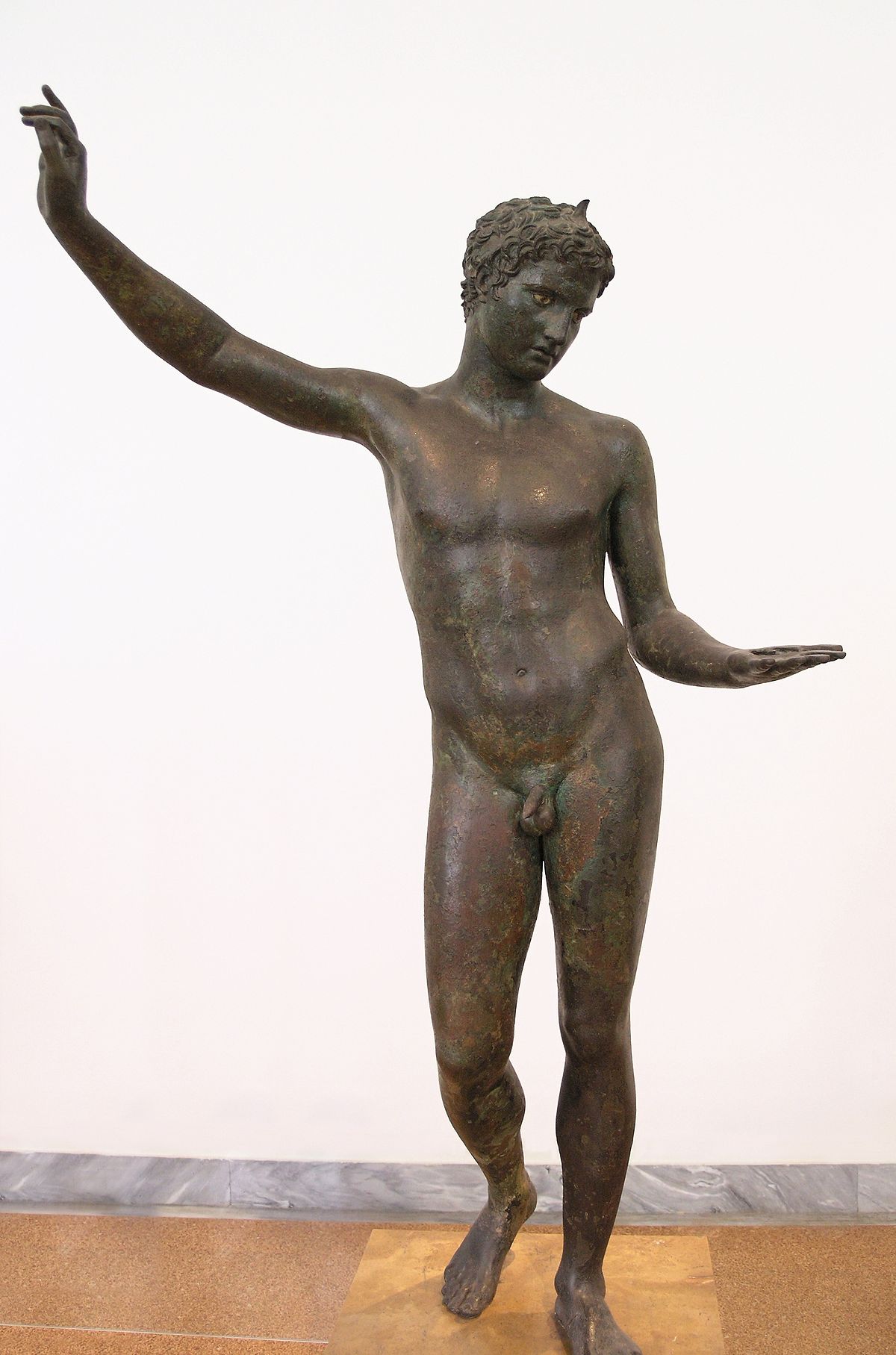
Name:
Date:
Era of Greek sculpture:
Artist:
Material:
Original and current location:
Original work or a copy:
Context:
Stylistic description:
Problems:
Marathon Boy
340-330 BC
Late Classical
Praxiteles
Bronze
Found in a shipwreck in the sea of Marathon
Currently in the NAM
Original
Context:
Found in a roman shipwreck so we have no idea who he is — maybe a victorious athlete
Style:
S-shaped torso an soft body
Tousled hair and locked gaze
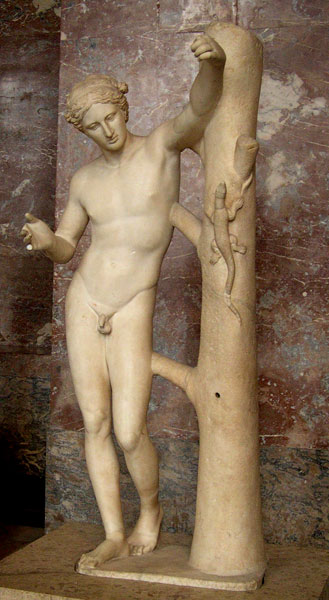
Name:
Date:
Era of Greek sculpture:
Artist:
Material:
Original and current location:
Original work or a copy:
Context:
Stylistic description:
Problems:
Apollo Sauroktonos
350 BC
Late Classical Period
Copy of a Praxiteles
Was bronze, now marble
Originally ? Now in the Louvre and Vatican have copies — Cleveland Museum of art claim to have the original
Copy
Context:
Apollo slays a giant serpent at Delphi and in the image there is a lizard he is about to crush.
Style:
More extreme version of the S-Curve and contraposto
Head tilt with tousled hair, soft face, and full lips
Soft body that doesn’t focus on musculature (feminine male body)
Problem:
The Cleveland Museum of Art claims to have the bronze original but its legs, nipples, and nose dont look Praxitelean
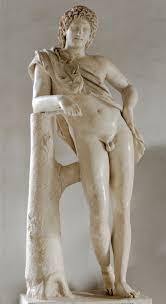
Name:
Date:
Era of Greek sculpture:
Artist:
Material:
Original and current location:
Original work or a copy:
Context:
Stylistic description:
Problems:
Satyr Anapauomenos / the Resting Satyr
350 BC
Late Classical
Original by Praxiteles
Originally bronze, now marble
Original lost, copy in Rome
Copy
Context:
Satyrs were followers of Dionysus. They were half man half beast that lived in the woods.
In earlier periods they were over-sexualized and beastial
Stylistic:
Has a leopard pelt
Tilt of the head and wild hair but no locked gaze (in a DREAMY STATE)
S-curve and soft body with less musculature but he’s still fit - sinuous curve
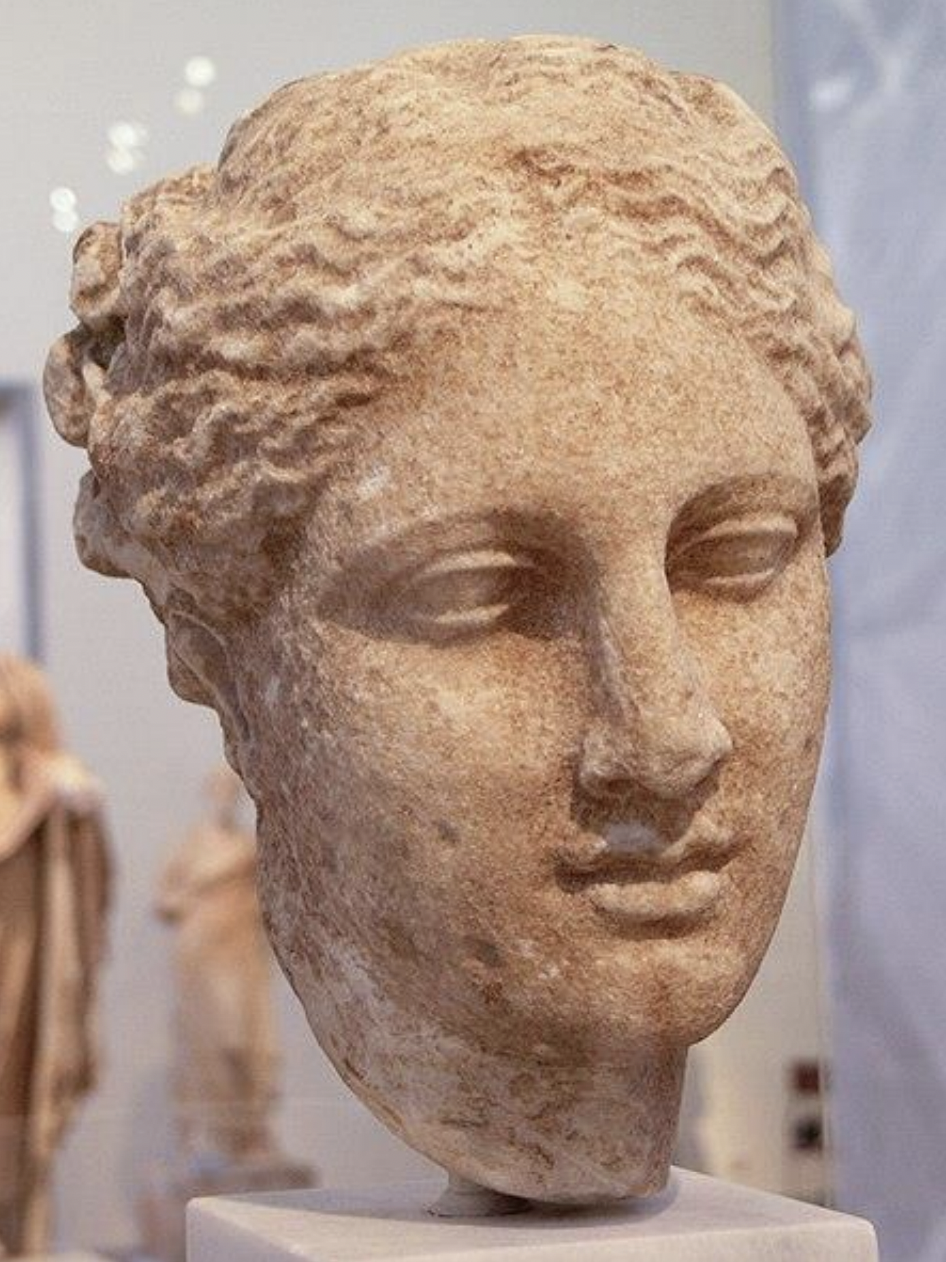
Name:
Date:
Era of Greek sculpture:
Artist:
Material:
Original and current location:
Original work or a copy:
Context:
Stylistic description:
Problems:
Hygeia / the Nymph
End of the Late Classical
Scopas
Marble
Temple of Athena Alea
NAM
Original
Daughter of Asklepios: god of healing
plague was ravanging Athens
deep set eyes, open full lips, soft features, up-do
may be a nymph
Evidence Praxiteles did Relief
Mantineia Base
Hellenistic Evolutionist theory vs Revolutionist Theory
A continuous gradual change vs the assumption that paradigms serve as stimuli until they are replaced by new paradigms
Culture under Alexander the Great
Empire spanned from Macedonian Greece to India which meant there were diverse languages, cultures, traditions, religion, diseases etc. leading to diversity
Greek identity in the Hellenistic
No Polis meant no citizenship and riches were no longer embarrassing so sculpture can be commissioned to your individual taste
Exposed to many new gods which changed how they viewed and depicted the Olympians
Koine
A greek word that means “share” referring to a Greek common stylistic language (culture and art) as the lingua franca of the Hellenistic world
Two poles of Hellenistic life
Transition from an Empire to a Kingdom and the focus on the individual
Three phases of the Hellenistic
The Diadochi / Age of Successors (323 to 275)
the Hellenistic Kingdoms (275-150)
The Graeco-Roman Era (150 -30)
4 philosophies of the Hellenistic
Stoicism
Epicurianism
Scepticism
Cynicism
Stoicism
a mild but not passive approach to life and cosmos; “this too shall pass”
Epicurianism
Placing pleasure first
Scepticism
Doubting everything — existentialism
Cynicism
Negativism— everything is doomed
5 Factors that shape Hellenistic art
Tyche (fortune)
Theatricality (dramatic effect and exaggeration)
Scientific Spirit
The establishment of the individual (not a citizen first)
Cosmopolitanism (world citizen— cities became diverse culture and opportunity wise)
Euergetism
Benefaction brings honor
the notion of generosity towards poorer citizens that included provision for entertainments and civic banquets but also city amenities such as theatres, baths, gymnasiums, fountains and markets that bore the inscription that so and so "built or repaired this with his own money
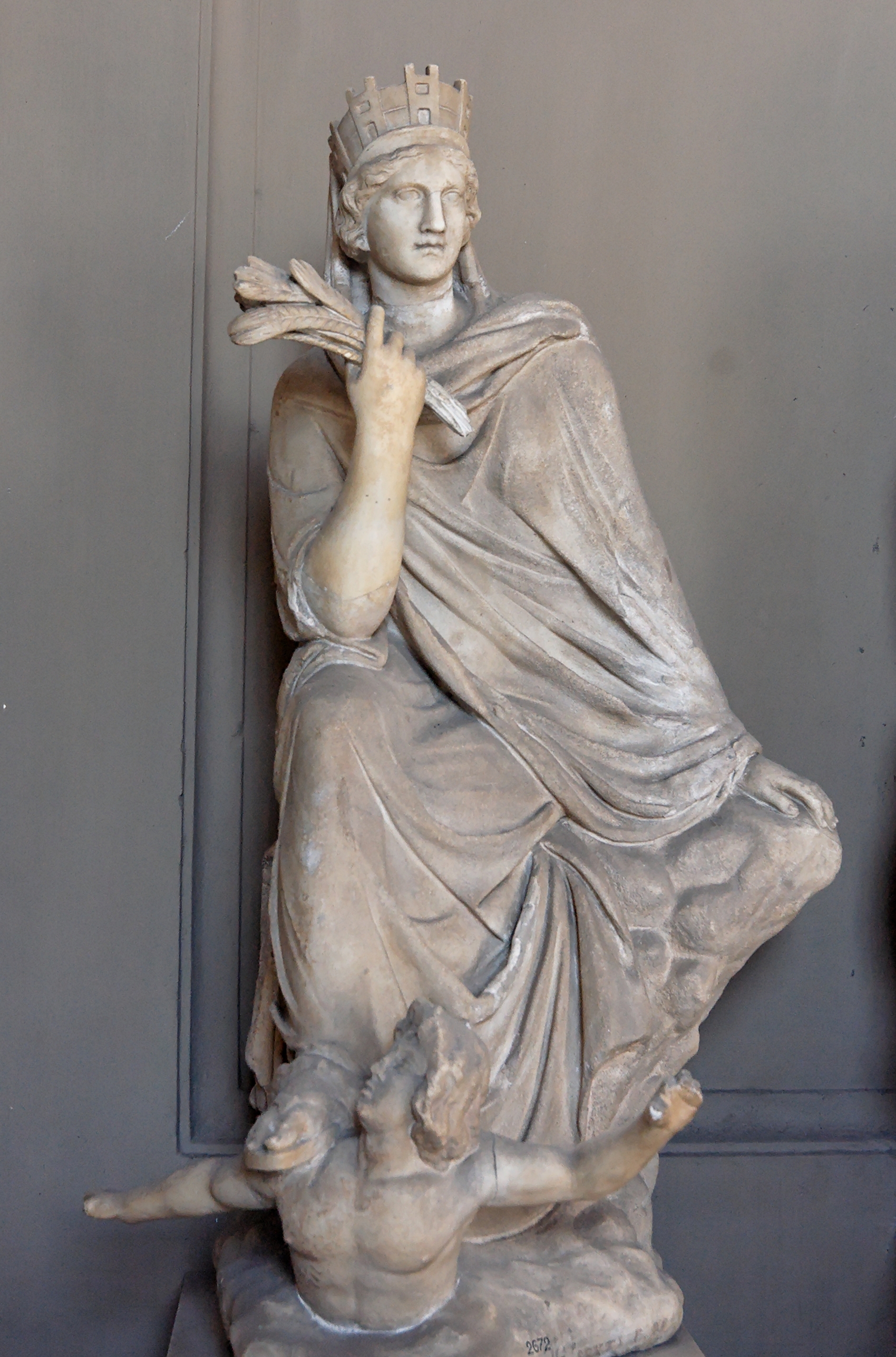
Name:
Date:
Era of Greek sculpture:
Artist:
Material:
Original and current location:
Original work or a copy:
Context:
Stylistic description:
Problems:
Tyche of Antioch
300 BC
The Age of Successors
Eutychides
Marble
Original is lost; Antioch = Syrian city
Copy in the Vatican
Personification of fortune aka the fortune of antioch
Holding wheat to symbolize bread and has a crown of the city walls
Sitting on a mountain which symbolizes sustanence
Stepping on the shoulder of the river Eranties
Style: lush half open lips, smaller head, smooth and round face
Sycretism
the nerging of the iconographic elements of two gods in art when two differing religions interact
Copies of Alexander the Great
Foundation of royal iconography
Lysippos was the the official portrait sculptor of Alexander the Great (creates Alexander the Hero King)
He depicted him with leonian hair, a left tilted head, an upward gaze, parted and full lips and a wrinkle on the forehead
Horns added later because he’s the son of Zeus
Portraiture as propaganda
Hellenistic sculpture overview (6 points)
Continuity with the Lysippan tradition
Personified concepts (Tyche)
Religious syncretism and art: Sarapis-Zeus
Portraits of kings, successors and wannabes
“the subjective vision” (Stewart) vs. a polis-bound shared ideal of sculpture (and life)
Two ‘schools’ of Hellenistic sculpture: Baroque and Rococo
Alexander copies
Pergamon Alexander (200 BC - Istanbul)
Alexander from Giannitsa
Four functions of Hellenistic sculpture
cult
votive
funerary
honorific (set up in the Agora to commemorate deeds of benefaction by glorious men)
Two kinds of women
1. The goddess, mostly (naked) Aphrodite
2. The elite mortal woman
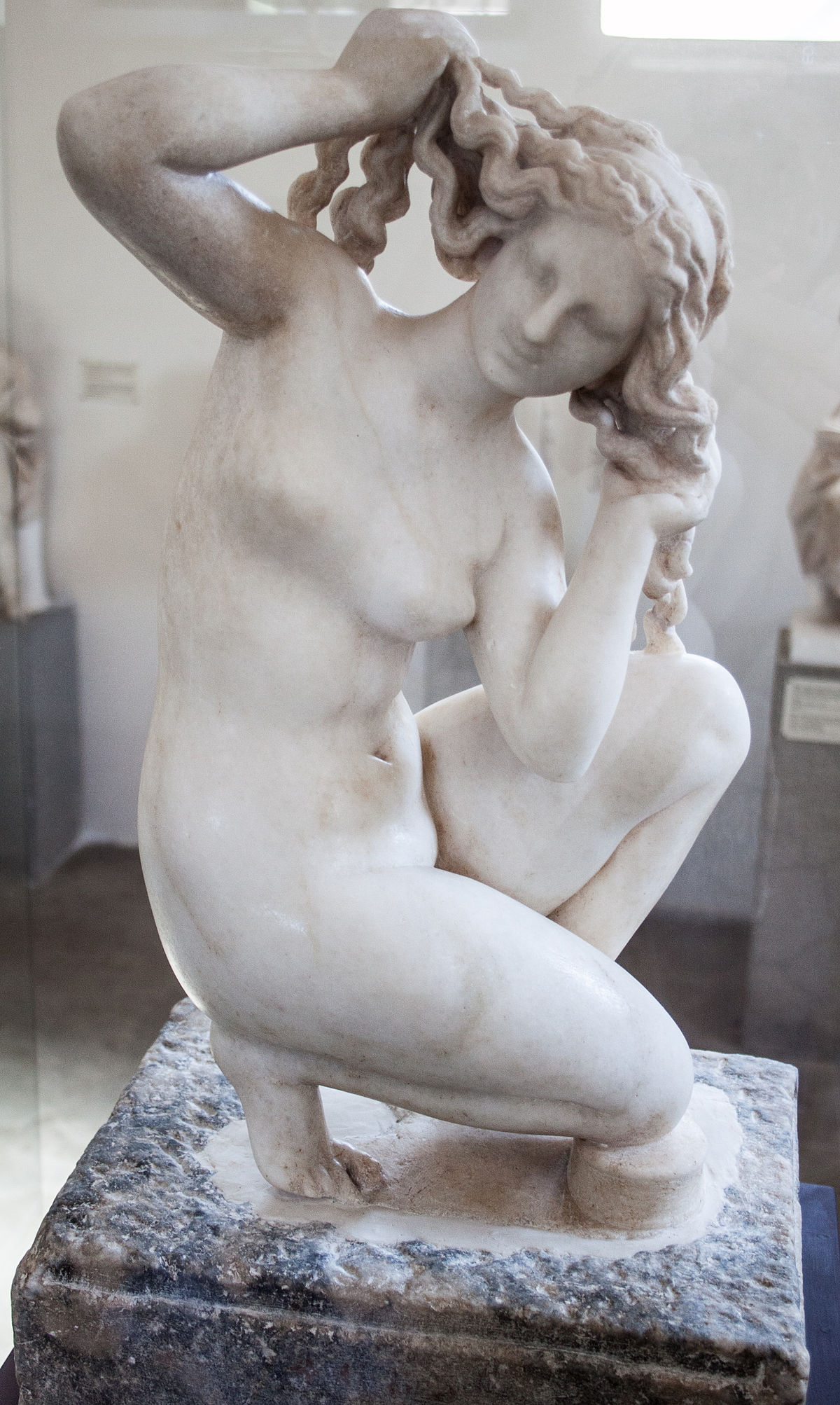
Name:
Date:
Era of Greek sculpture:
Artist:
Material:
Original and current location:
Original work or a copy:
Context:
Stylistic description:
Problems:
The Crouching Venus of Rhodes
3rd century BC original
Hellenistic
Doedalsas
Parian Marble
Rhodes
Copy
Aphropdite = goddess of love
naked = Praxiteles / sex
kneeling after bathing
open display of breasts but no vagina
Roman villa decoration
Style: Rococo
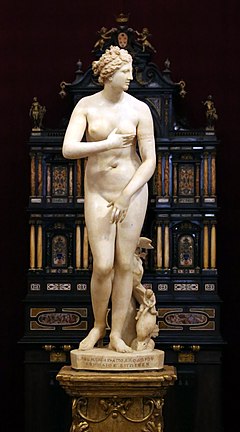
Name:
Date:
Era of Greek sculpture:
Artist:
Material:
Original and current location:
Original work or a copy:
Context:
Stylistic description:
Problems:
Medici Aphrodite
First century BC copy of Aphrodite of Knidos (360 - 330BC)
Hellenistic
Unknown
Marble
Florence
Copy

Name:
Date:
Era of Greek sculpture:
Artist:
Material:
Original and current location:
Original work or a copy:
Context:
Stylistic description:
Problems:
Venus de Milo
2nd C
Hellenistic
unknown- possibly Alexandros - based on Praxitelen type
Parian marble
Greek island of Milos → Louvre, France
copy
context: Aphrodite of Knidos
Style:
Features such as the small, regular eyes and mouth, and the strong brow and nose, are classical in style
the shape of the torso and the deeply carved drapery are Hellenistic
Influenced 19th-century art and the Surrealist movement in the early 20th century
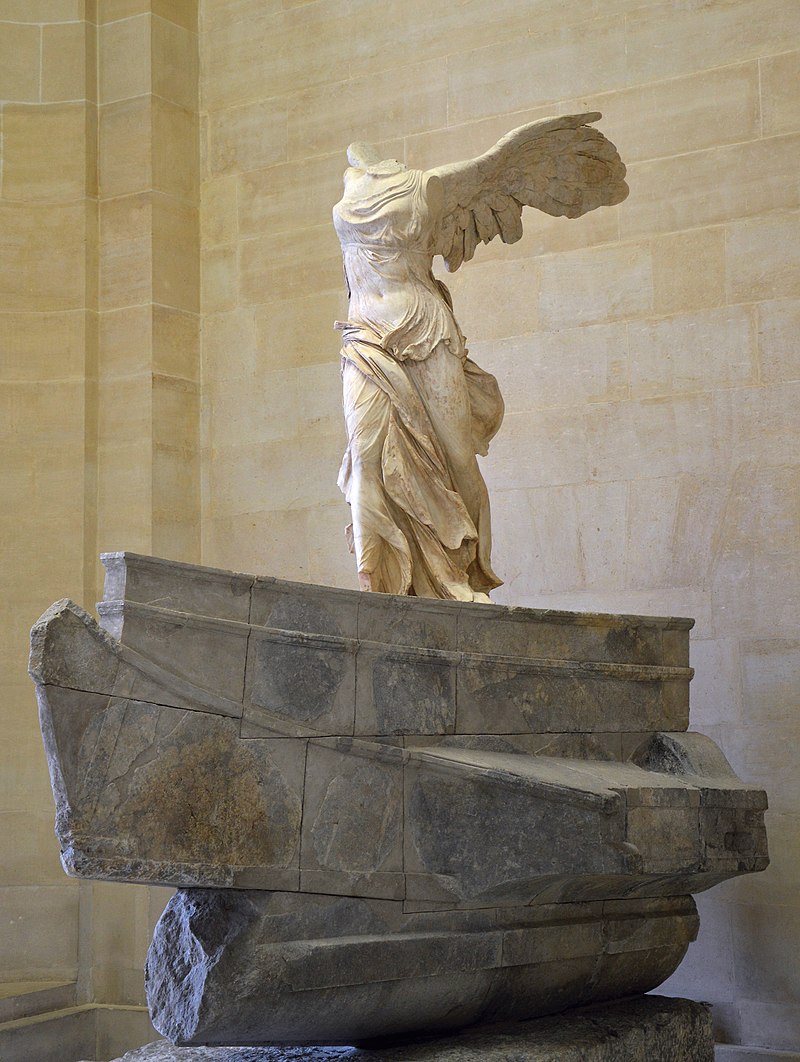
Name:
Date:
Era of Greek sculpture:
Artist:
Material:
Original and current location:
Original work or a copy:
Context:
Stylistic description:
Problems:
Nike of Samothrance
190 BC
Hellenistic
Parian marble with a base of grey Lartos marble
Excavated on Samothrace (ancient sanctuary dedicated to the Great Gods), now in the Louvre, France
Context:
Purpose: commemorate a victory in a naval battle and tribute to Nike
During the Hellenistic period, the sanctuary of the Great Gods underwent intensive renovations when the successors of Alexander the Great (356-323 BCE) tried to surpass each other in generosity and were committed to beautifying and enlarging the temple complex.
Style:
Set to be viewed from three quarters (back has less detail)
The masterly rendering of the wavy drapes of her pleated chitōn (tunic) leaves the impression the Nike descends from the heavens in mid-storm
Over her tunic, she wears a himation (mantle), which covers her right leg and is blown against her body by the imaginary force of the sea wind.
Baroque place of origin
Pergamon and Rhodes
Baroque style
“weird” style popular in Pergamon and Rhodes in which everything is exaggerated (deep drilling, dramatic poses, contorted facial expressions)
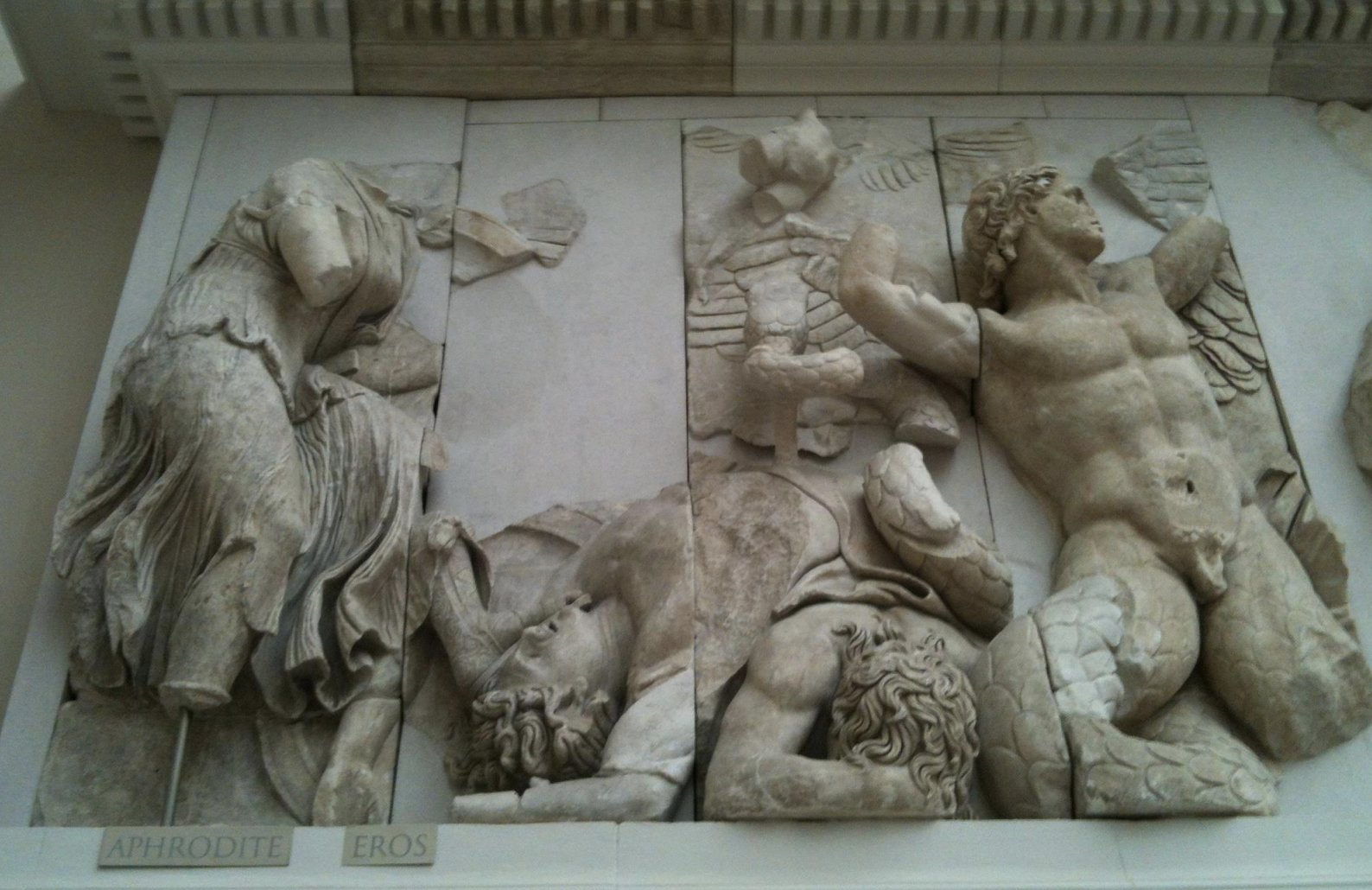
Name:
Date:
Era of Greek sculpture:
Artist:
Material:
Original and current location:
Original work or a copy:
Context:
Stylistic description:
Problems:
The Gigantomachy Frieze of the Great Altar of Pergamon
200-160 BC
Hellenistic
16-40 sculptors; don’t know the mastermind
Marble with veins in it
Pergamon to Berlin
Original
Context:
Altar to Zeus
Exception in the Hellenistic for Architectural Sculpture
Special because it’s in-situ
Pergamene Kings’ ambition to connect their life and deeds with Periclean Athens and Pheidian Acropolis
Story of the Olympians and the giants fighting (narrative)
Style:
Very high relief
Not continuous frieze
Dynamic poses, frontality, entanglement, massive body volume
drapery used to accentuate other figures
head tilt, deep-set eyes, hair, plump lips
proportions and body’s reactions are very naturalistic
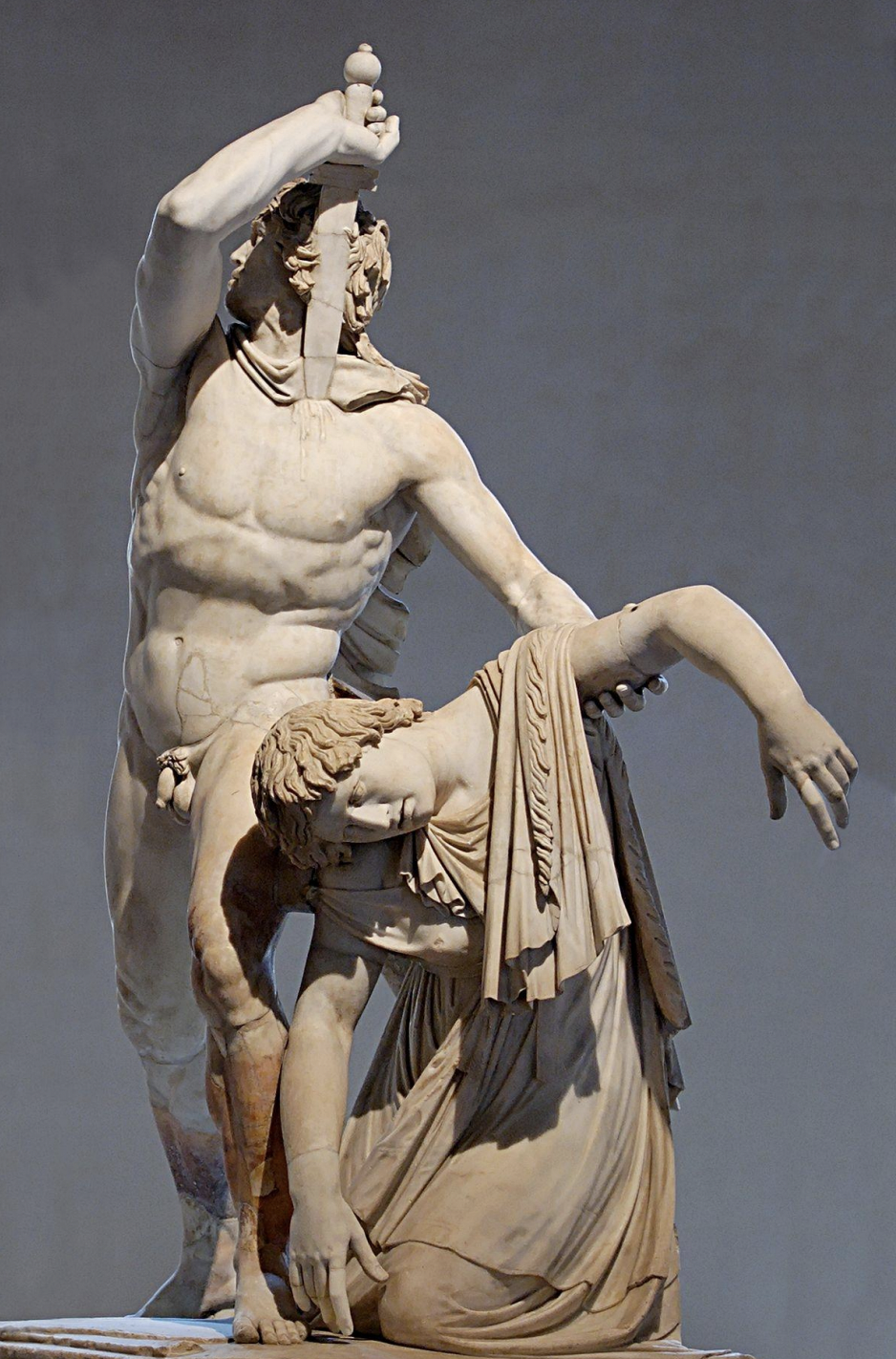
Name:
Date:
Era of Greek sculpture:
Artist:
Material:
Original and current location:
Original work or a copy:
Context:
Stylistic description:
Problems:
Large Gaul Group
230 BC
Hellenistic
Epigonus
original bronze, copy Marble
Original: Pergamon, copies in Rome
Celebrating victory over the Gaul (Celtics) who were the “others” / barbarians in the Hellenistic world
Shows how brave the greeks are by showing how tough their enemies were
Leader of the Gauls killing himself and his wife to avoid capture
Style:
ultra realism — see knee wound
baroque - very dramatic poses and expressions
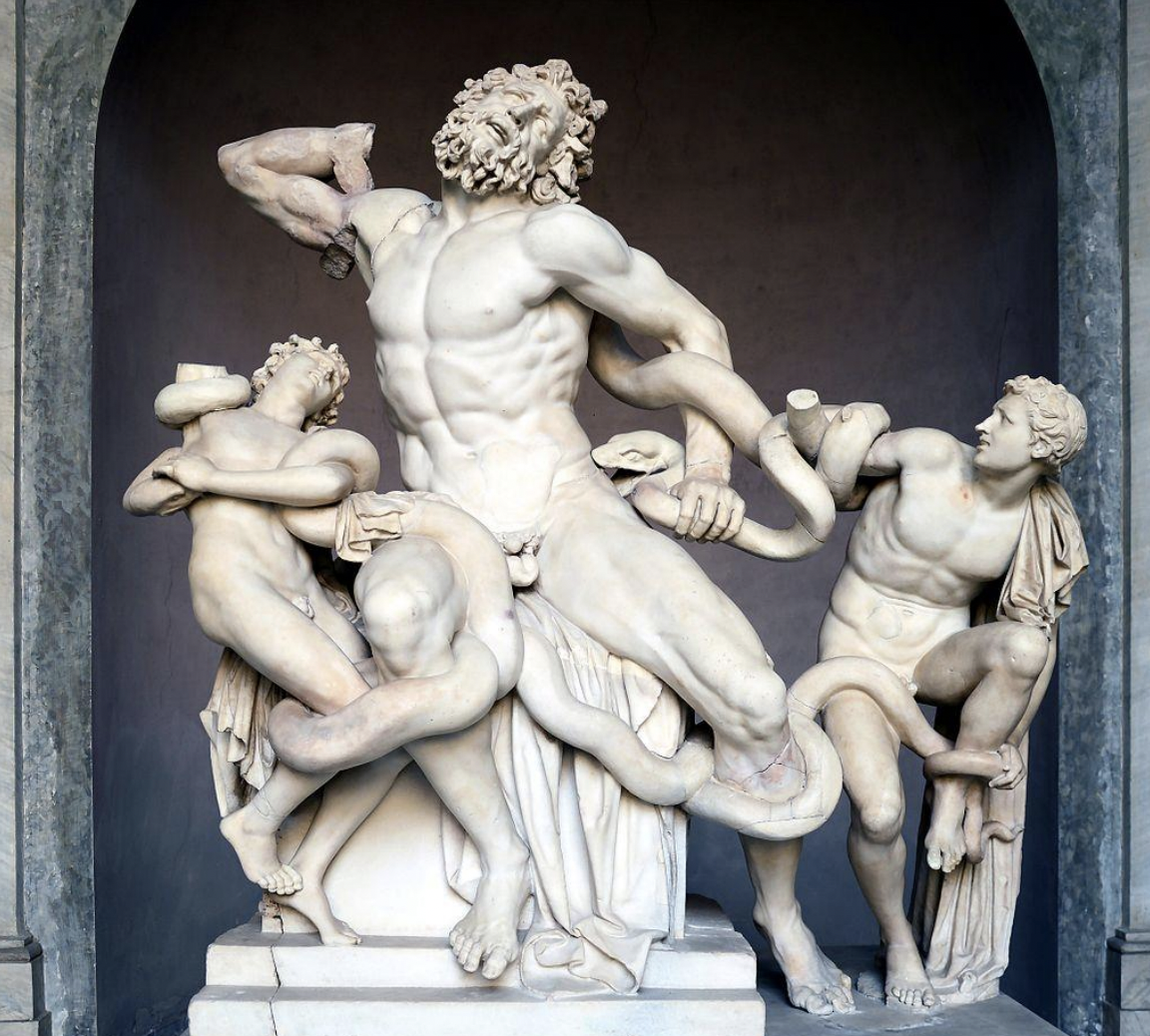
Name:
Date:
Era of Greek sculpture:
Artist:
Material:
Original and current location:
Original work or a copy:
Context:
Stylistic description:
Problems:
Laocoon and His Sons
200 BC -70 AD
Hellenistic or Roman
three craftsmen from Rhodes (Agesander, Athenodorus and Polydorus)
bronze originally marble
original maybe Pergamon- now in Rome
Copy
troy story
baroque
arms renaissance
Pliny the Elder
Rococo
Lighter and more joyful themes revolving around Dionysus’s circle while still paying close attention to detail
Often decor for the wealthy
4 types of Hellenistic Rococo
Nymphs and Satyrs
Women
Children
Ornamental reliefs in the archaistic style
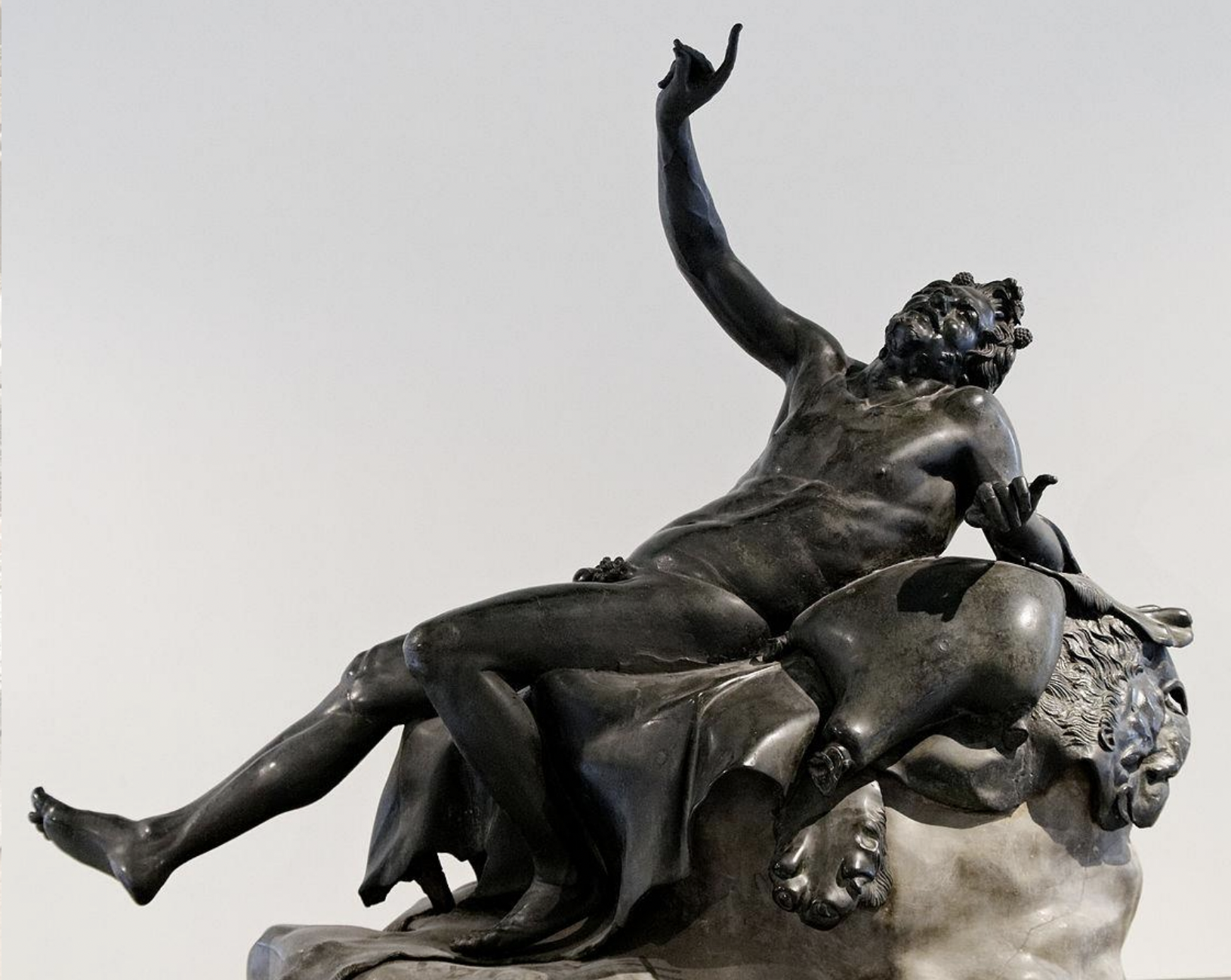
Name:
Date:
Era of Greek sculpture:
Artist:
Material:
Original and current location:
Original work or a copy:
Context:
Stylistic description:
Problems:
The Drunken Satyr
late 1st c BC, but type was invented earlier
Hellenistic
Unknown
Bronze
Herculaneum (Villa de Papyri) → Naples
Rococo style
drunken stupor
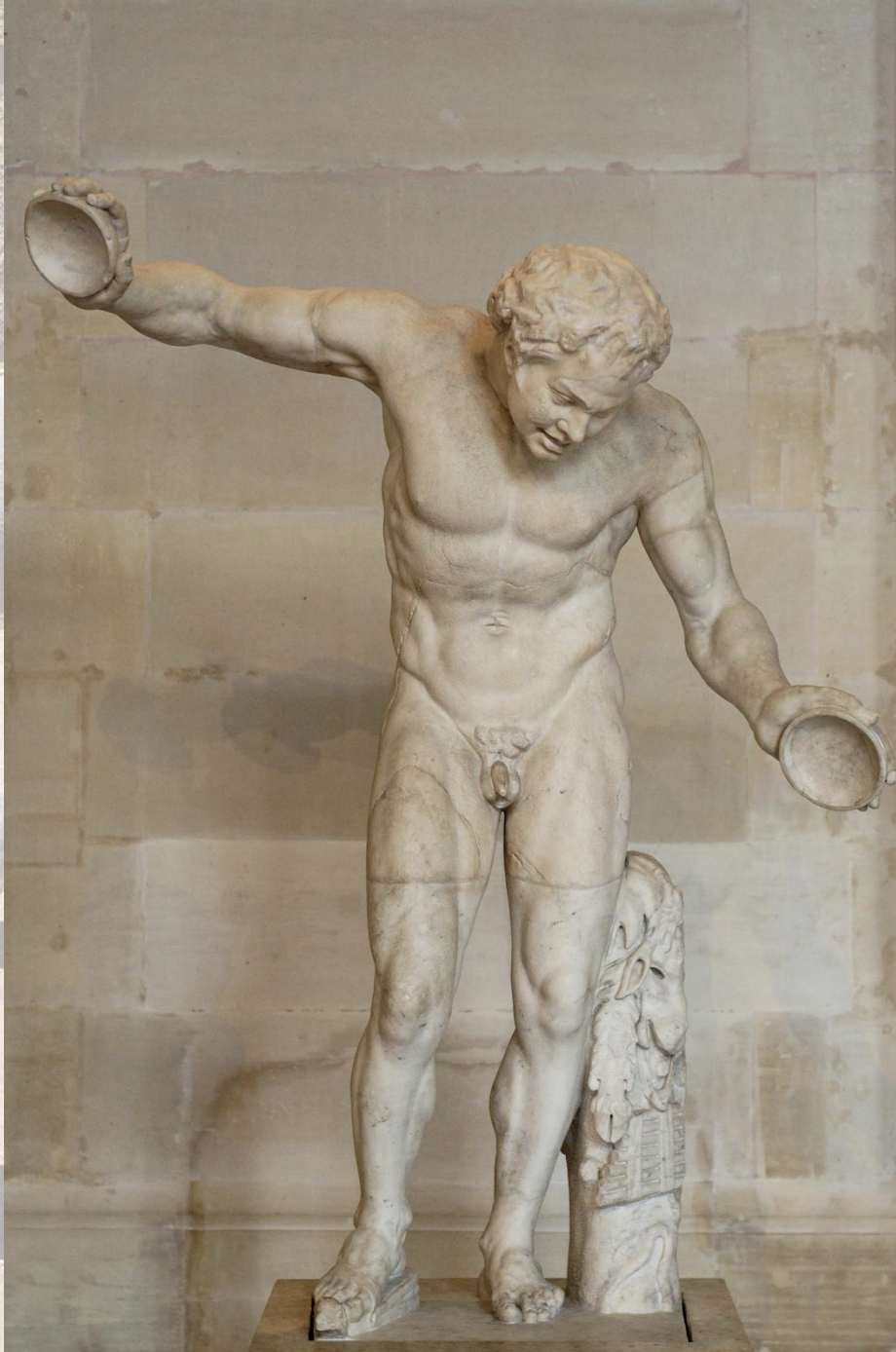
Name:
Date:
Era of Greek sculpture:
Artist:
Material:
Original and current location:
Original work or a copy:
Context:
Stylistic description:
Problems:
Invitation to Dance
150 BC
Hellenistic
marble
Roman copy in the Louvre
Nymph adjusting her sandal while a saytr dances for her to entice her
light scene — no assault
glorification of the human body
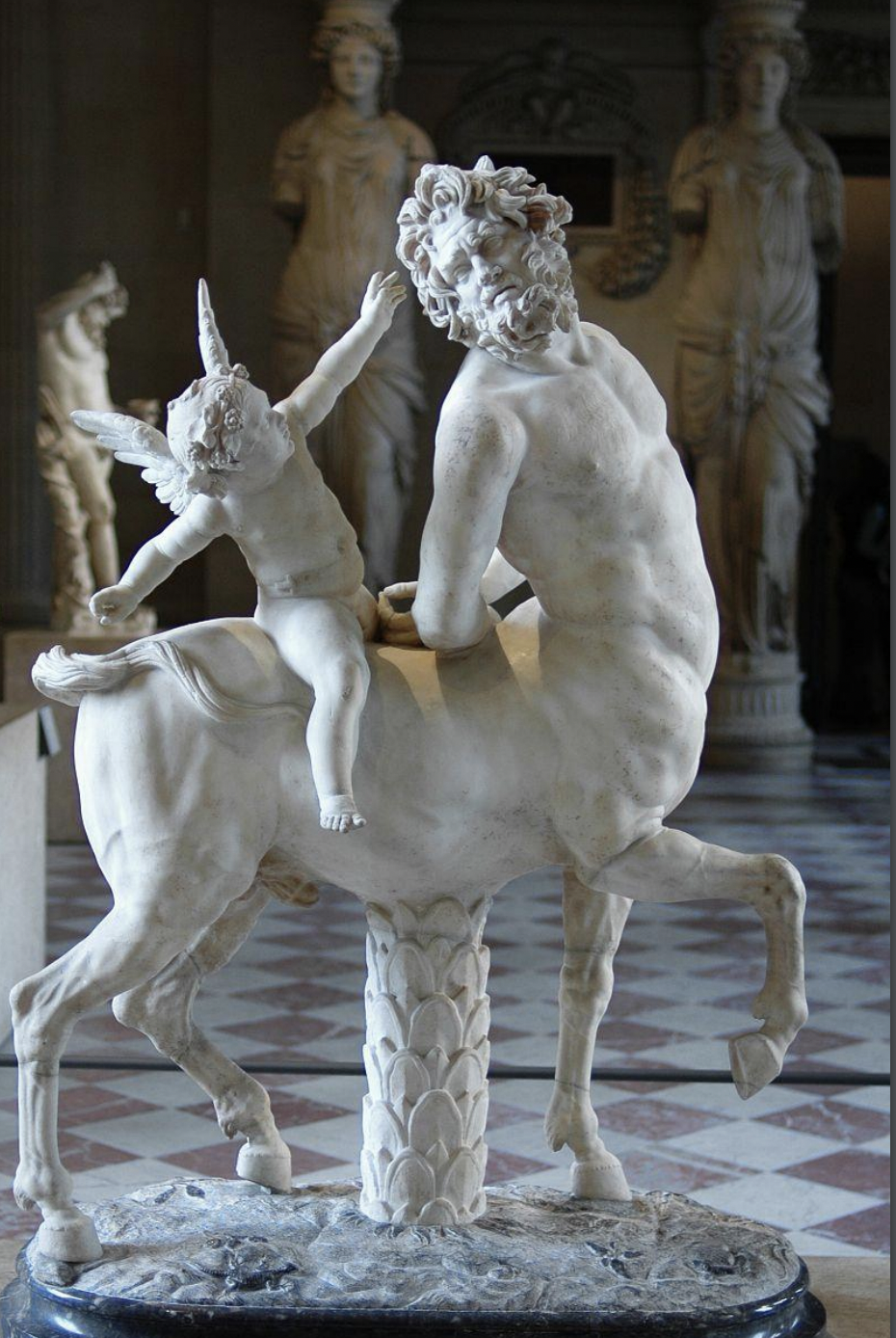
Name:
Date:
Era of Greek sculpture:
Artist:
Material:
Original and current location:
Original work or a copy:
Context:
Stylistic description:
Problems:
Eros and the Centaur
original bronze late 2nd c, roman copy made in the 2nd c AD
Made and found in Rome , now in the Louvre
Masterfully made but repeated types
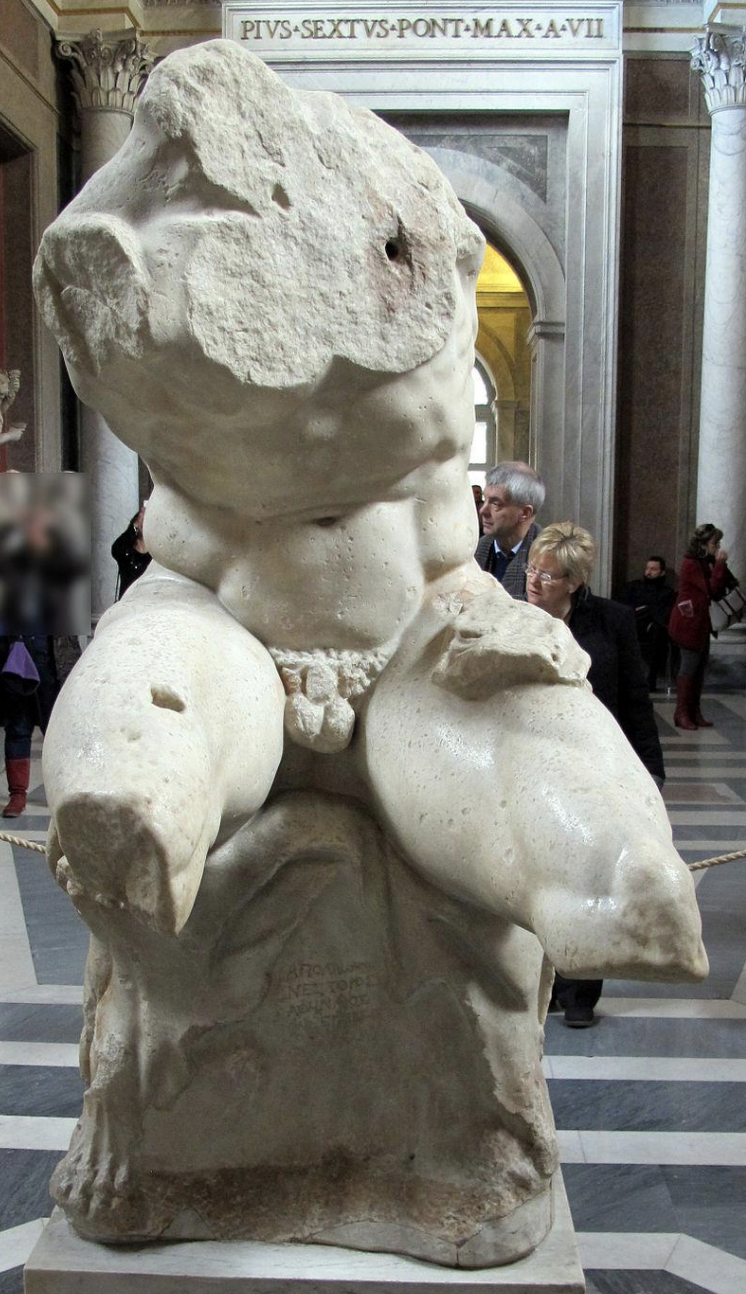
Name:
Date:
Era of Greek sculpture:
Artist:
Material:
Original and current location:
Original work or a copy:
Context:
Stylistic description:
Problems:
Belvedere Torso
Rome, Vatican Museum
Inscribed with Apollonios
Original = early 2nd c BC
Copy = 1st c BC or AD
Hellenistic
Marble
who is it? Ajax? Heracles?
Influenced Michaelangelo’s Last Judgement
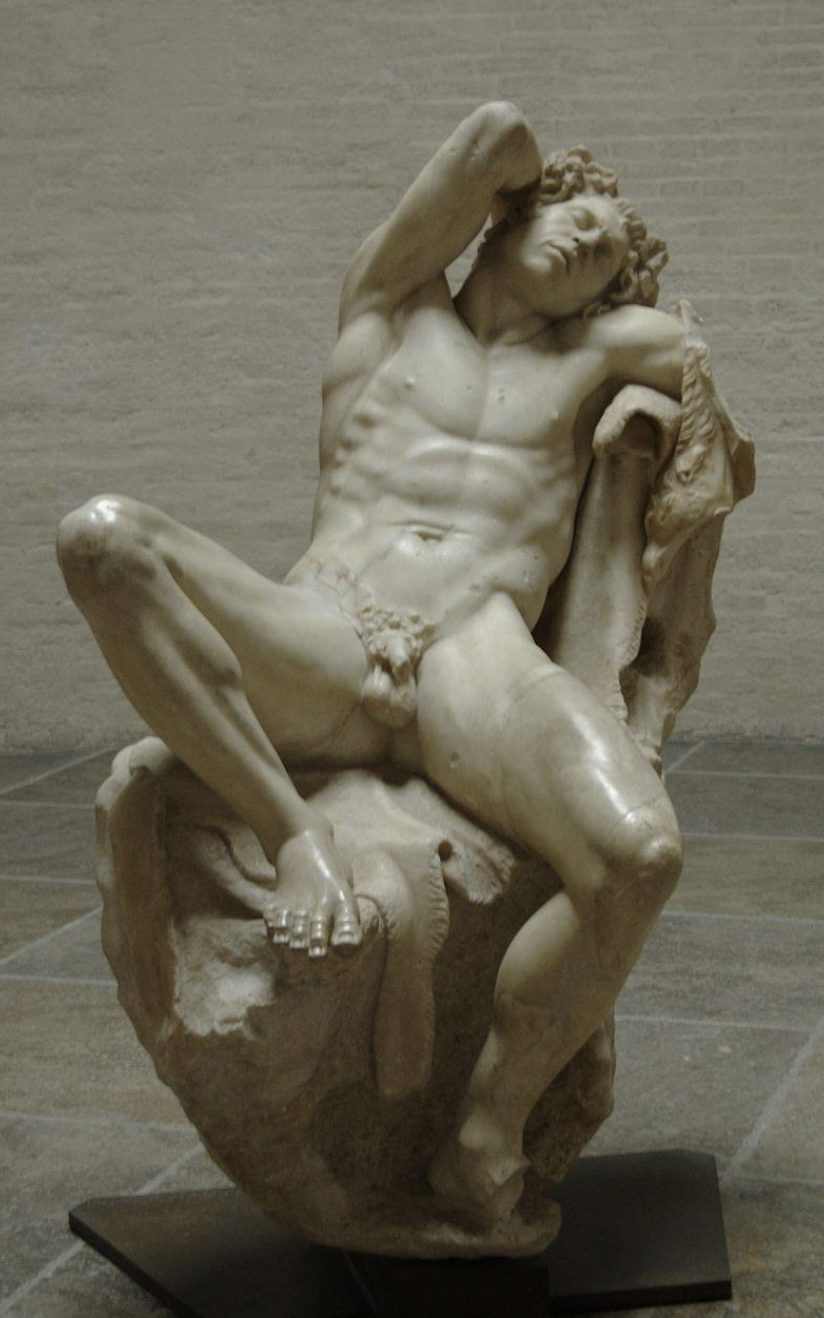
Name:
Date:
Era of Greek sculpture:
Artist:
Material:
Original and current location:
Original work or a copy:
Context:
Stylistic description:
Problems:
Barberini Faun
2nd c BC or Roman copy
Hellenistic
Marble
Found in Rome, now in Munich
Social Realism
third type of Hellenistic Sculpture that depict the human condition: the figures are tired, drunk, poor, old, children, disfigured or out-of-shape.
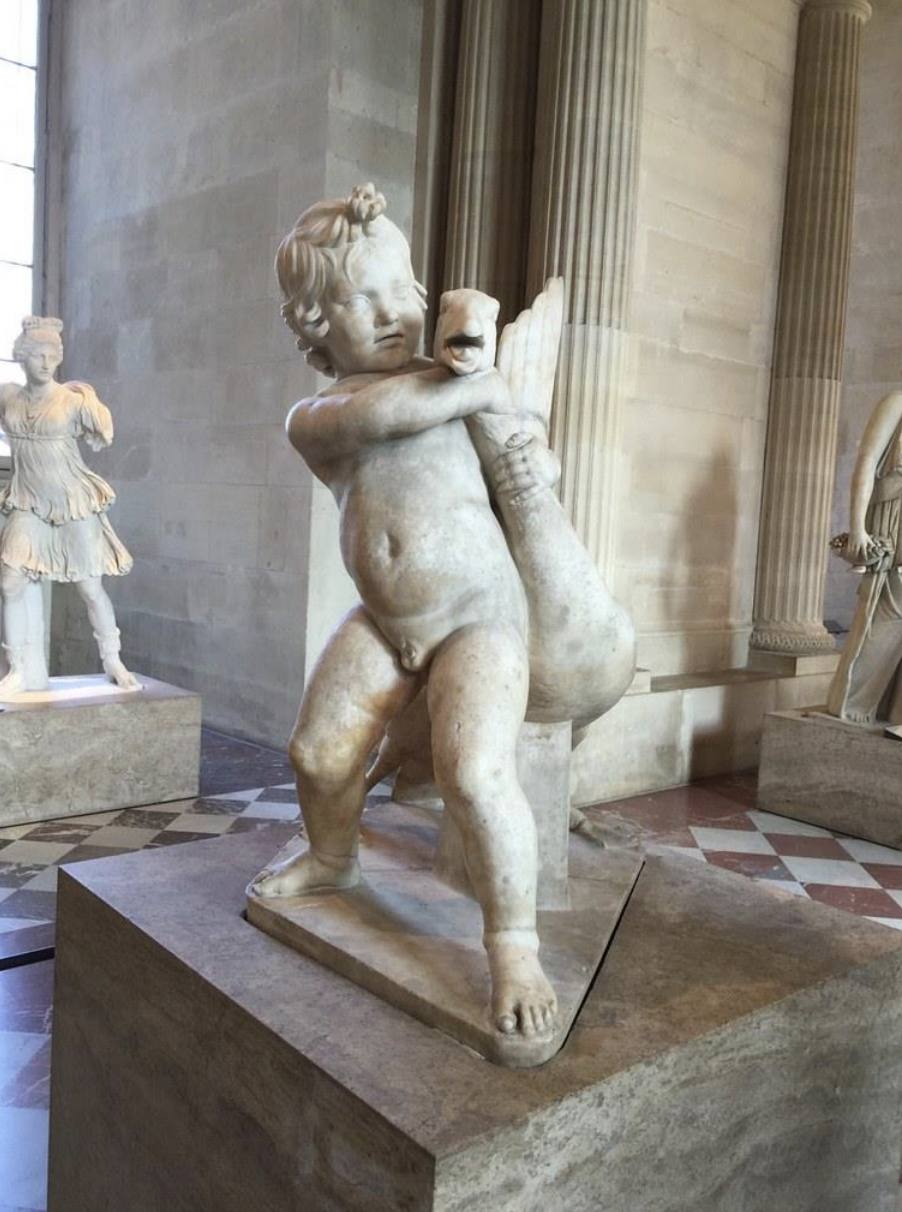
Name:
Date:
Era of Greek sculpture:
Artist:
Material:
Original and current location:
Original work or a copy:
Context:
Stylistic description:
Problems:
Boy Strangling Goose
230-200 orginal
marble copy
Vatican Museum
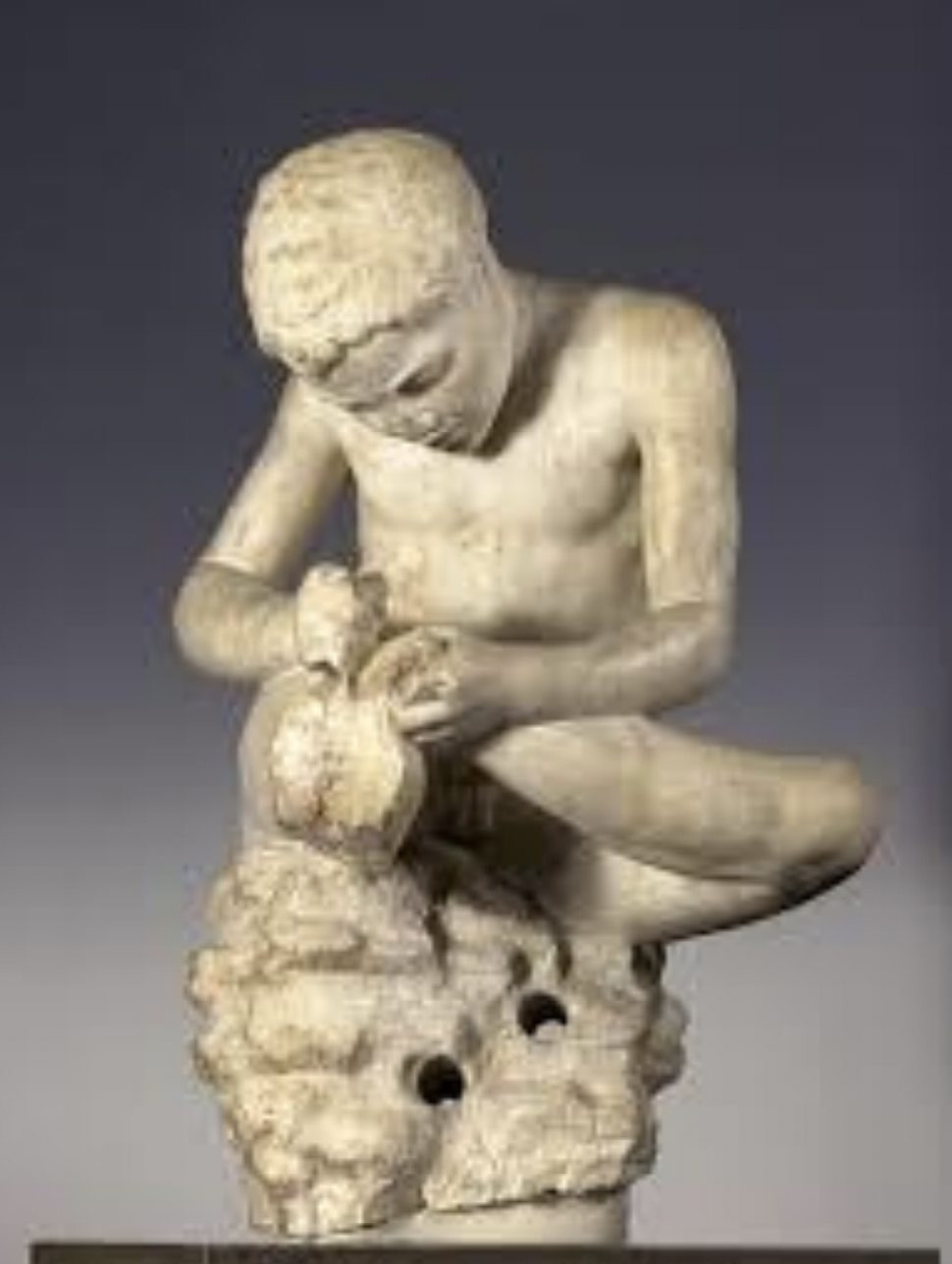
The Spinario
Rome → British Museum
3rd c BC original— roman copy
marble
removing a thorn from his foot
rock has been drilled to accommodate a pipe for a fountain.
Epidarus sculptor
Timotheos and Hektoridas
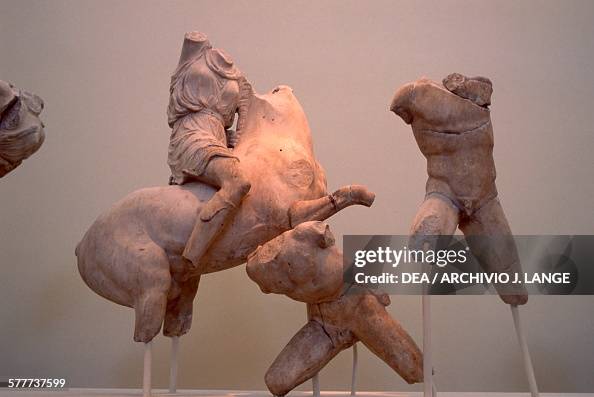
West Pediment of the Temple of Asclepius depicting the Amazonomachy
410-400 BC
Timotheos and Hektoridas
Emphasis on the Amazons who are winning the battle
Greek men are cowering\Wet drapery effect and nudity (legs) but not sexual
taking full advantage of space
see anatomy of man dying in the corner
4th century political climate
The Peloponnesian War and Plague leaves no room for self-deceit
The polis is not a powerhouse anymore
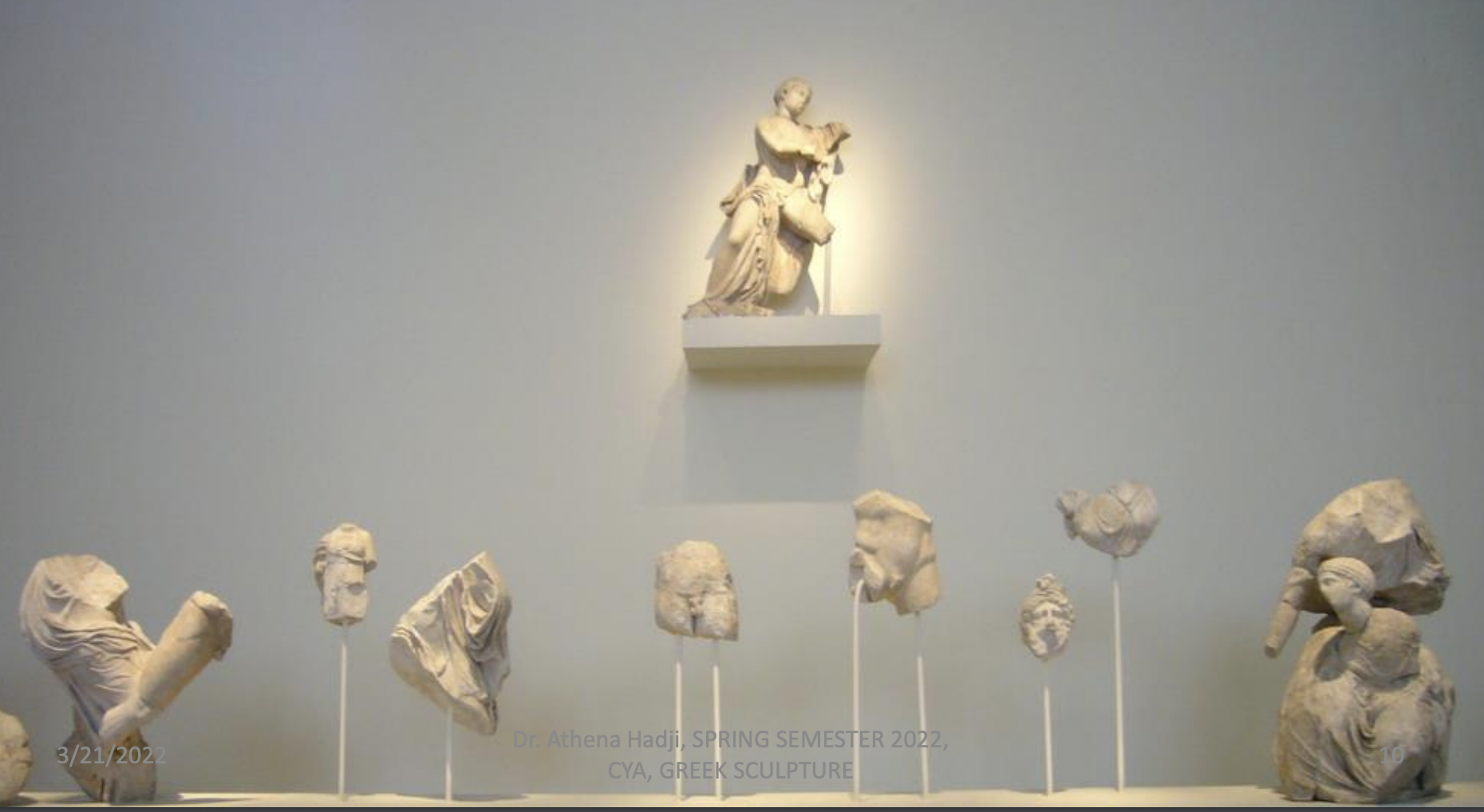
East Pediment if the Temple of Asclepius at Epidarus
400-410 BC
Timotheos and Hektoridas
depicts the battle at Troy, but the greek are the bad guys
raping and disrespecting elders
not idealized
pathos

Name:
Date:
Era of Greek sculpture:
Artist:
Material:
Original and current location:
Original work or a copy:
Context:
Stylistic description:
Problems:
Apoxyomenos (the Scraper)
330 BC
Late Classical
Lyssipus
Rome at a bathhouse
original bronze, copy Penetelic marble
Votive image of an athlete scraping sweat and dust from his body
long thing limbs, small head,
“true” contrapposto
movement and all angles

Name:
Date:
Era of Greek sculpture:
Artist:
Material:
Original and current location:
Original work or a copy:
Context:
Stylistic description:
Problems:
Herakles of the Farnese Type
320 BC original
Late Classical
Lysippos
marble (og bronze)
Anikethera shipwreck
Copy
Name:
Date:
Era of Greek sculpture:
Artist:
Material:
Original and current location:
Original work or a copy:
Context:
Stylistic description:
Problems:
Apollo Patroos
340 BC
Late Classical
Euphanor
marble
Athenian Agora
Original
Apollo of the fathers — protector of families and tribes
Euphanor style: slender body with a large head and limbs — dignity of heroes
Cult statue of the temple of Apollo Petros (see size and lack of weathering)
not clinging drapery— deep grooves
women like figure